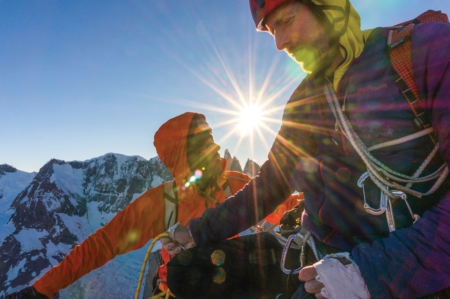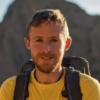Exactly Where You Are Supposed To Be
Tommy Caldwell's first trip to Patagonia
I’ve made four trips to Patagonia, including a traverse with Alex Honnold, a trip on which I did almost nothing; and one where Josh Wharton and I blazed up the 2,700-meter (8,858-foot) Aguja Standhardt—the northern summit in the Cerro Torre group. But my first trip in 2006 was one of the most impactful climbing experiences in my life.
I was 27 when I went with Topher Donahue, my neighbor in Estes Park, Colorado, and the brother of a childhood pal. Topher had originally planned the trip with his father, Mike, who had passed away before they could go. Topher was a Patagonia veteran, I was a tyro, though I had grown up climbing with my own father in places like Longs Peak in Rocky Mountain National Park and on El Cap.
We set up below the Fitz Roy massif and, in the era before forecasting was readily available, cast off on the Royal Flush. The wind started as soon as we began. We quickly climbed 20 pitches of wet cracks with cold water running down to our elbows. Though protected from the wind, which tends to be single-directional in Patagonia, we watched wheelbarrow-sized ice chunks fly sideways off the mountaintop. We spent a bone-chilling night out and set off in the morning, but turned around only two or three pitches below a low-angle ridge to the top. At a ledge, Topher pulled out a vial and emptied an arc of ashes, telling me, “My dad was with us the whole time.”
From there, we started back down the glacier. As we emerged from the wind shelter of the mountain, the blasts knocked me off my feet. I’d grown up in a wind-scoured place, but the Patagonian wind was unlike anything I’d ever experienced. We’d have to lie down and self-arrest on the glacier. When I took off my helmet to change clothing layers, it rocketed out of sight.
But the retreat didn’t bother me. We’d gone up without expectations, and I discovered on that climb how I responded to the intensity of the experience. Topher and I then waited out a month of bad weather, camping with other international climbers. We resigned ourselves to leave empty-handed when, three days before we were set to leave, a window opened.
This time we tried a different route, Linea di Eleganza, with our friend Erik Roed, who had a topo. The route was established by an Italian party two years before, in iced-up conditions and with aid, over nine days. Five hours into the glacier approach, stopping to scope the mountain, we realized we’d lost the topo. It didn’t really matter. Our chances weren’t great or even good, and Patagonia had already delivered a series of ass kickings.
Again we set out without expectations, but then plugged all the way up. I was happy to be on dry rock and have led the crux pitch. We climbed into the night, with Topher leading an unprotected verglassed corner, and gained the top having made a free ascent. We reached the base again after 50 hours on the move—and three sunrises.
On the walk out, I experienced a great sense of convergence. It combined the memory of spreading Mike Donahue’s ashes, an appreciation for the mentorship and partnership with Topher, and the downtime with climbers I respected. I felt like I was exactly where I was supposed to be.
My whole life up to then, I had always felt a little awkward. Even in sport climbing. I didn’t quite fit the mold. Patagonia suited me perfectly. I loved the adventure, the adversity—it took all the skills I had acquired—and the camaraderie. It just all seemed so right.

